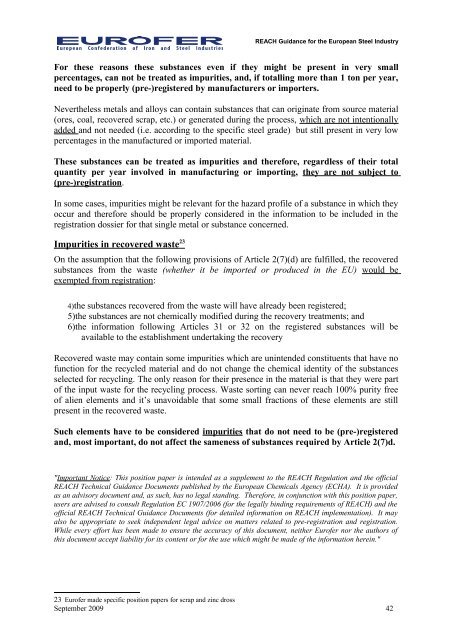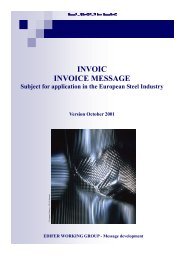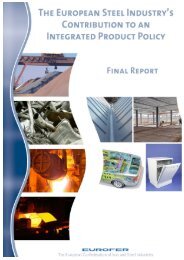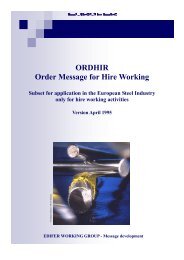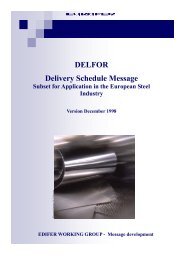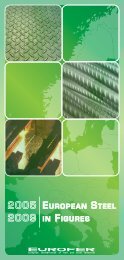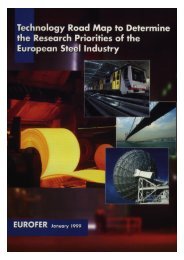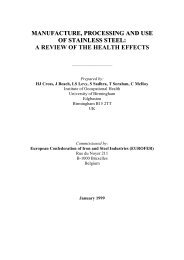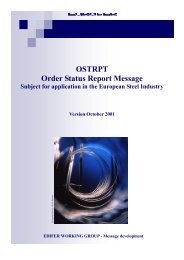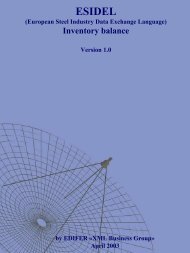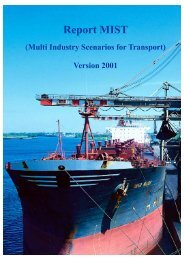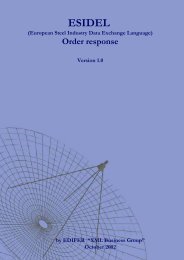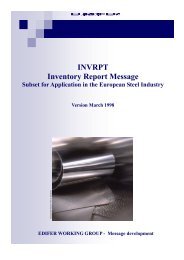EUROFER REACH guidance for the European Steel Industry. 09.09 ...
EUROFER REACH guidance for the European Steel Industry. 09.09 ...
EUROFER REACH guidance for the European Steel Industry. 09.09 ...
Create successful ePaper yourself
Turn your PDF publications into a flip-book with our unique Google optimized e-Paper software.
<strong>REACH</strong> Guidance <strong>for</strong> <strong>the</strong> <strong>European</strong> <strong>Steel</strong> <strong>Industry</strong><br />
For <strong>the</strong>se reasons <strong>the</strong>se substances even if <strong>the</strong>y might be present in very small<br />
percentages, can not be treated as impurities, and, if totalling more than 1 ton per year,<br />
need to be properly (pre-)registered by manufacturers or importers.<br />
Never<strong>the</strong>less metals and alloys can contain substances that can originate from source material<br />
(ores, coal, recovered scrap, etc.) or generated during <strong>the</strong> process, which are not intentionally<br />
added and not needed (i.e. according to <strong>the</strong> specific steel grade) but still present in very low<br />
percentages in <strong>the</strong> manufactured or imported material.<br />
These substances can be treated as impurities and <strong>the</strong>re<strong>for</strong>e, regardless of <strong>the</strong>ir total<br />
quantity per year involved in manufacturing or importing, <strong>the</strong>y are not subject to<br />
(pre-)registration.<br />
In some cases, impurities might be relevant <strong>for</strong> <strong>the</strong> hazard profile of a substance in which <strong>the</strong>y<br />
occur and <strong>the</strong>re<strong>for</strong>e should be properly considered in <strong>the</strong> in<strong>for</strong>mation to be included in <strong>the</strong><br />
registration dossier <strong>for</strong> that single metal or substance concerned.<br />
Impurities in recovered waste<br />
23<br />
On <strong>the</strong> assumption that <strong>the</strong> following provisions of Article 2(7)(d) are fulfilled, <strong>the</strong> recovered<br />
substances from <strong>the</strong> waste (whe<strong>the</strong>r it be imported or produced in <strong>the</strong> EU) would be<br />
exempted from registration:<br />
4)<strong>the</strong> substances recovered from <strong>the</strong> waste will have already been registered;<br />
5)<strong>the</strong> substances are not chemically modified during <strong>the</strong> recovery treatments; and<br />
6)<strong>the</strong> in<strong>for</strong>mation following Articles 31 or 32 on <strong>the</strong> registered substances will be<br />
available to <strong>the</strong> establishment undertaking <strong>the</strong> recovery<br />
Recovered waste may contain some impurities which are unintended constituents that have no<br />
function <strong>for</strong> <strong>the</strong> recycled material and do not change <strong>the</strong> chemical identity of <strong>the</strong> substances<br />
selected <strong>for</strong> recycling. The only reason <strong>for</strong> <strong>the</strong>ir presence in <strong>the</strong> material is that <strong>the</strong>y were part<br />
of <strong>the</strong> input waste <strong>for</strong> <strong>the</strong> recycling process. Waste sorting can never reach 100% purity free<br />
of alien elements and it’s unavoidable that some small fractions of <strong>the</strong>se elements are still<br />
present in <strong>the</strong> recovered waste.<br />
Such elements have to be considered impurities that do not need to be (pre-)registered<br />
and, most important, do not affect <strong>the</strong> sameness of substances required by Article 2(7)d.<br />
"Important Notice: This position paper is intended as a supplement to <strong>the</strong> <strong>REACH</strong> Regulation and <strong>the</strong> official<br />
<strong>REACH</strong> Technical Guidance Documents published by <strong>the</strong> <strong>European</strong> Chemicals Agency (ECHA). It is provided<br />
as an advisory document and, as such, has no legal standing. There<strong>for</strong>e, in conjunction with this position paper,<br />
users are advised to consult Regulation EC 1907/2006 (<strong>for</strong> <strong>the</strong> legally binding requirements of <strong>REACH</strong>) and <strong>the</strong><br />
official <strong>REACH</strong> Technical Guidance Documents (<strong>for</strong> detailed in<strong>for</strong>mation on <strong>REACH</strong> implementation). It may<br />
also be appropriate to seek independent legal advice on matters related to pre-registration and registration.<br />
While every ef<strong>for</strong>t has been made to ensure <strong>the</strong> accuracy of this document, nei<strong>the</strong>r Eurofer nor <strong>the</strong> authors of<br />
this document accept liability <strong>for</strong> its content or <strong>for</strong> <strong>the</strong> use which might be made of <strong>the</strong> in<strong>for</strong>mation herein."<br />
23 Eurofer made specific position papers <strong>for</strong> scrap and zinc dross<br />
September 2009 42


